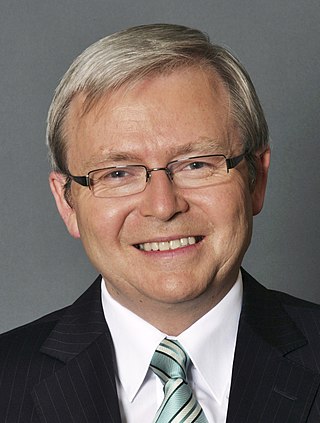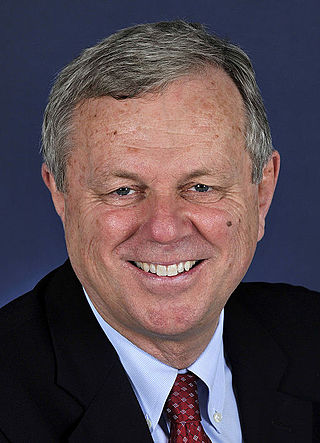
The 2007 Australian federal election was held in Australia on 24 November 2007. All 150 seats in the House of Representatives and 40 of the seats in the 76-member Senate were up for election. The election featured a 39-day campaign, with 13.6 million Australians enrolled to vote.
The Division of Mayo is an Australian electoral division located to the east and south of Adelaide, South Australia. Created in the state redistribution of 3 September 1984, the division is named after Helen Mayo, a social activist and the first woman elected to an Australian University Council. The 9,315 km2 rural seat covers an area from the Barossa Valley in the north to Cape Jervis in the south. Taking in the Adelaide Hills, Fleurieu Peninsula and Kangaroo Island regions, its largest population centre is Mount Barker. Its other population centres are Aldgate, Bridgewater, Littlehampton, McLaren Vale, Nairne, Stirling, Strathalbyn and Victor Harbor, and its smaller localities include American River, Ashbourne, Balhannah, Brukunga, Carrickalinga, Charleston, Cherry Gardens, Clarendon, Crafers, Cudlee Creek, Currency Creek, Delamere, Echunga, Forreston, Goolwa, Gumeracha, Hahndorf, Houghton, Inglewood, Kersbrook, Kingscote, Langhorne Creek, Lobethal, Macclesfield, McLaren Flat, Meadows, Middleton, Milang, Mount Compass, Mount Pleasant, Mount Torrens, Mylor, Myponga, Normanville, Norton Summit, Oakbank, Penneshaw, Piccadilly, Port Elliot, Second Valley, Springton, Summertown, Uraidla, Willunga, Woodchester, Woodside, Yankalilla, and parts of Birdwood, Old Noarlunga and Upper Sturt.

The state election for the 51st Parliament of South Australia was held in the Australian state of South Australia on 18 March 2006 to elect all members of the South Australian House of Assembly and 11 members of the South Australian Legislative Council. The election was conducted by the independent State Electoral Office.
The following pendulum is known as the Mackerras pendulum, invented by psephologist Malcolm Mackerras. Designed for the outcome of the 2007 federal election, the pendulum works by lining up all of the seats held in Parliament, 83 Labor, 55 Liberal, 10 National, and 2 independent, according to the percentage point margin on a two candidate preferred basis, as elected in 2007. The two candidate result is also known as the swing required for the seat to change hands. Given a uniform swing to the opposition or government parties in an election, the number of seats that change hands can be predicted. Swing is never uniform, but in practice variations of swing among the Australian states usually tend to cancel each other out. Seats are arranged in safeness categories according to the Australian Electoral Commission's classification of safeness. "Safe" seats require a swing of over 10 per cent to change, "fairly safe" seats require a swing of between 6 and 10 per cent, while "marginal" seats require a swing of less than 6 per cent.
The following pendulum is known as the Mackerras pendulum, invented by psephologist Malcolm Mackerras. Designed for the outcome of the 2010 federal election, the pendulum works by lining up all of the seats held in Parliament, 72 Labor, 72 Coalition, 1 Nationals WA, 1 Green and 4 independent, according to the percentage point margin on a two candidate preferred basis. The two party result is also known as the swing required for the seat to change hands. Given a uniform swing to the opposition or government parties in an election, the number of seats that change hands can be predicted. Swing is never uniform, but in practice variations of swing among the Australian states usually tend to cancel each other out. Seats are arranged in safeness categories according to the Australian Electoral Commission's classification of safeness. "Safe" seats require a swing of over 10 per cent to change, "fairly safe" seats require a swing of between 6 and 10 per cent, while "marginal" seats require a swing of less than 6 per cent.
The following is a Mackerras pendulum for the 2006 Victorian state election.
The following is a Mackerras pendulum for theNew South Wales state election 2007.
The following pendulum is known as the Mackerras pendulum, invented by psephologist Malcolm Mackerras. Designed for the outcome of the 2010 Victorian state election, the pendulum works by lining up all of the seats held in Parliament, according to the percentage point margin on a two candidate preferred basis. The two party result is also known as the swing required for the seat to change hands. Given a uniform swing to the opposition or government parties in an election, the number of seats that change hands can be predicted. Swing is never uniform, but in practice variations of swings usually tend to cancel each other out. "Safe" seats require a swing of over 10 per cent to change, "fairly safe" seats require a swing of between 6 and 10 per cent, while "marginal" seats require a swing of less than 6 per cent.
The following is a pendulum based on the outcome of the 2010 federal election and changes since, including the redistributions of seats in South Australia and Victoria. It is a Mackerras pendulum, invented by psephologist Malcolm Mackerras, which works by lining up all of the seats held in Parliament according to the percentage point margin on a two-candidate-preferred basis. The two-party result is also known as the swing required for the seat to change hands. Given a uniform swing to the opposition or government parties in an election, the number of seats that change hands can be predicted. Swings are never uniform, but in practice variations of swing among the Australian states usually tend to cancel each other out. Seats are arranged in safeness categories according to the Australian Electoral Commission's (AEC) classification of safeness. "Safe" seats require a swing of over 10 per cent to change, "fairly safe" seats require a swing of between 6 and 10 per cent, while "marginal" seats require a swing of less than 6 per cent. The swings for South Australian and Victorian seats are notional, based on calculations by the AEC.
The following is a Mackerras pendulum for the 2002 Victorian state election.
The following is a Mackerras pendulum for the 1999 Victorian state election.
The following is a Mackerras pendulum for the 1992 Victorian state election.
The following is a Mackerras pendulum for the 1996 Victorian state election.
The following pendulum is known as the Mackerras pendulum, invented by psephologist Malcolm Mackerras. Based upon the outcome of the 2007 federal election and changes before the 2010 election, the pendulum works by lining up all of the seats held in Parliament, 83 Labor, 55 Liberal, 9 National, and 3 independent, according to the percentage point margin on a two party preferred basis.
The following is a Mackerras pendulum for the 2014 Victorian state election.
The following is a Mackerras pendulum for the 2015 Queensland state election.
The following is a Mackerras pendulum for the 2015 New South Wales state election.
The following is a Mackerras pendulum for the 2017 Queensland state election.
The following is a Mackerras pendulum for the 2019 New South Wales state election.
The following is a Mackerras pendulum for the 2020 Queensland state election.